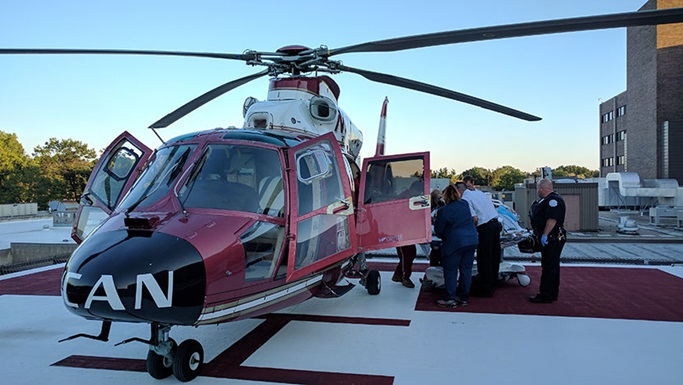Imagine you’re in a situation where your newborn baby or child is in need of urgent medical care and the closest hospital with the necessary resources is miles away. It’s a terrifying thought, but thankfully, there are specialized air ambulance units that are specifically equipped to handle neonatal and pediatric transports. These units are designed to provide a safe and efficient means of transportation for young patients who require critical care during transit. In this article, we’ll take a closer look at these specialized air ambulance units and how they play a vital role in saving the lives of our little ones. So, let’s buckle up and get ready to soar into the world of neonatal and pediatric transport!

Overview of Specialized Air Ambulance Units
Air ambulance units play a critical role in providing emergency medical care to individuals who require immediate transportation to specialized medical facilities. Within the realm of air ambulance services, there are special units that cater specifically to neonatal and pediatric patients. These specialized units are equipped with the necessary medical equipment and personnel to ensure the safe and efficient transportation of these vulnerable populations.
Neonatal Transport
Neonatal transport refers to the transportation of newborn babies who require specialized medical care. This may include premature infants, babies with congenital abnormalities, or those in critical condition. The scope of neonatal transport extends beyond simply moving the baby from one location to another. It involves ensuring a stable environment during transportation, as well as providing medical interventions when necessary.
To facilitate neonatal transport, specialized air ambulance units are equipped with incubators, ventilators, and monitors to closely monitor the baby’s vital signs. These units also have a dedicated team of medical professionals, such as neonatologists and neonatal nurses, who have received comprehensive training in neonatal care.
Common conditions that may require neonatal air ambulance transport include respiratory distress syndrome, congenital heart defects, and neonatal sepsis. These conditions often necessitate immediate medical attention that may not be available at the initial healthcare facility.
Transporting newborns by air ambulance presents unique challenges and considerations. The fragility of these tiny patients requires extra precautions to ensure their safety. Temperature control, protection from vibrations, and maintaining a sterile environment are crucial during neonatal transport.
Pediatric Transport
Similar to neonatal transport, pediatric transport involves the transportation of children who require specialized medical care. This may include children with severe injuries, chronic illnesses, or those in need of life-saving procedures. The scope of pediatric transport encompasses the same principles as neonatal transport but expands to include older children up to the age of 18.
Pediatric air ambulance units are equipped with age-appropriate medical equipment and a specialized team of healthcare professionals, including pediatricians and pediatric nurses. These professionals have the expertise to assess and manage the unique medical needs of pediatric patients during transport.
Common pediatric conditions that may require air ambulance transport include severe trauma, organ failure, and acute respiratory distress syndrome. The ability to provide timely and specialized care through air transportation can significantly improve the chances of a positive outcome for these young patients.
Challenges in pediatric transport may involve ensuring the emotional well-being of the child during transport, managing pain and discomfort, and addressing the specific medical needs of pediatric patients in terms of medication dosages and medical interventions.
Training and Expertise
The personnel involved in specialized air ambulance units, including neonatal and pediatric transport, require specific qualifications and training to ensure the highest standard of care. Air medical crews, regardless of their specialty, are required to possess a certain level of medical expertise.
For neonatal and pediatric transport, medical crews often undergo additional specialized training. This training focuses on the unique medical needs of these populations and equips the crews with the necessary skills to manage emergencies and provide appropriate care.
Continuing education and certification are vital for air medical crews to stay updated with the latest advancements and guidelines in neonatal and pediatric care. This ensures that they are equipped with the knowledge and skills needed to provide optimal care during transport.
Equipment and Technology
Specialized air ambulance units for neonatal and pediatric transport are equipped with specific medical equipment and advanced life support technology to ensure the well-being of patients during transport.
These units are equipped with incubators or warmers to maintain the baby’s body temperature, as well as respiratory equipment such as ventilators to provide respiratory support. Cardiac monitors, pulse oximeters, and other diagnostic tools are also essential for continuous monitoring during the flight.
Advanced life support technology, such as portable defibrillators, infusion pumps, and intravenous access devices, are essential in managing emergencies and providing life-saving interventions when needed.
Temperature control systems are critical in neonatal and pediatric transport to maintain an appropriate environment for these vulnerable patients. This includes insulation to prevent temperature fluctuations and keeping the interior of the aircraft at a stable temperature.
Safety Measures
Ensuring the safety of patients during air ambulance transport is paramount. Specialized air ambulance units employ various safety measures to protect their patients.
Secure patient packaging techniques are employed to ensure that neonatal and pediatric patients are safely and comfortably secured during the flight. This includes using harnesses, padding, and specialized equipment to prevent movement and reduce the risk of injuries.
Infection control procedures are strictly followed to minimize the risk of nosocomial infections during transport. The air ambulance units maintain a sterile environment and adhere to stringent protocols for disinfection and sterilization.
Flight safety and emergency preparedness are crucial in the operation of specialized air ambulance units. The crews undergo rigorous training in aviation safety and emergency response to manage any unforeseen circumstances during transport effectively.
Medical Protocols and Procedures
Specialized air ambulance units for neonatal and pediatric transport follow specific medical protocols and procedures to ensure the optimal care of patients during transport.
Stabilization and assessment of the patient’s condition are the initial steps in the transport process. This includes evaluating vital signs, assessing the severity of the patient’s condition, and initiating appropriate interventions to stabilize the patient.
Pharmacological interventions may be required during transport to manage pain, ensure adequate sedation, or treat specific medical conditions. Air medical crews are trained to administer medications safely and accurately according to the patient’s needs.
Ventilation and respiratory support are vital in managing neonatal and pediatric patients. The crews are proficient in providing respiratory support, including the use of ventilators and oxygen therapy, to maintain adequate oxygenation and ventilation.
Monitoring and diagnostic tools, such as continuous cardiac monitoring, pulse oximetry, and blood gas analysis, are utilized to monitor the patient’s condition throughout the transport. These tools provide valuable information to the medical crew, enabling them to make informed decisions regarding the patient’s care.
Communication and Coordination
Effective communication and coordination are essential for the successful transport of neonatal and pediatric patients. Specialized air ambulance units work closely with ground medical staff to ensure a seamless transition of care.
Collaboration between the air ambulance team and the ground medical staff is crucial for sharing pertinent medical information, exchanging updates on the patient’s condition, and ensuring continuity of care.
A robust communication infrastructure is essential to facilitate communication during transport. This includes reliable communication systems, such as two-way radios and cellular phones, to maintain constant contact between the air ambulance team, the receiving medical facility, and the referring healthcare providers.
Patient handover procedures are followed to ensure a smooth transition of care. This involves providing a comprehensive report to the receiving medical facility, including the patient’s medical history, current condition, and any ongoing treatments or interventions.
Operational Considerations
Specialized air ambulance units face various operational considerations to ensure the smooth and efficient delivery of their services.
Air ambulance aircraft selection is crucial to accommodate the specific requirements of neonatal and pediatric patients. The aircraft must have adequate space to accommodate medical equipment, temperature control systems, and the necessary personnel. The aircraft should also be capable of providing a smooth and stable flight to protect the well-being of the patients.
Optimal flight routing and planning are essential to minimize travel time and ensure the patient’s safety. Consideration is given to factors such as weather conditions, airspace restrictions, and the availability of appropriate medical facilities at the destination.
Legal and regulatory compliance is adhered to by specialized air ambulance units. These units must comply with aviation regulations as well as adhere to medical standards and guidelines to maintain the highest level of patient safety.
Logistical challenges, such as coordinating ground transportation and ensuring the availability of medical resources at the receiving facility, are carefully managed to guarantee a smooth transition of the patient’s care.
Neonatal and Pediatric Transport Guidelines
To ensure the appropriate utilization of neonatal and pediatric air ambulance transport services, specific guidelines are followed.
Transport eligibility criteria are established to determine when air ambulance transport is necessary and appropriate for neonatal and pediatric patients. These criteria consider factors such as the severity of the patient’s condition, the required level of medical care, and the distance to the receiving facility.
Referral and coordination processes are in place to ensure efficient communication between the referring healthcare facility, the air ambulance unit, and the receiving medical facility. This facilitates a seamless transfer of the patient’s care to the appropriate level of expertise and resources.
Transport decision-making is guided by these guidelines to ensure that the most appropriate method of transport is chosen for each neonatal and pediatric patient. Factors such as medical stability, the patient’s condition, and the availability of specialized resources at the receiving facility are carefully considered in making these decisions.
In conclusion, specialized air ambulance units for neonatal and pediatric transport play a vital role in providing rapid and specialized medical care to these vulnerable populations. With the right equipment, knowledgeable medical staff, and adherence to strict protocols, these units ensure the safe and efficient transport of neonatal and pediatric patients, increasing their chances of a positive outcome.



